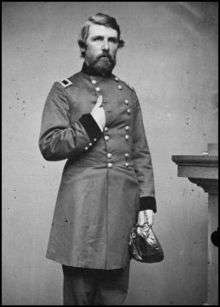Charles Smith Hamilton
Charles Smith Hamilton (November 16, 1822 – April 17, 1891) was a career United States Army officer who fought with distinction during the Mexican-American War. He also served as a Union Army general during the early part of the American Civil War.
Charles Smith Hamilton | |
|---|---|
 Charles Smith Hamilton photo taken between 1861 and 1862 | |
| Born | November 16, 1822 Westernville, New York |
| Died | April 17, 1891 (aged 68) Milwaukee, Wisconsin |
| Place of burial | Forest Home Cemetery, Milwaukee, Wisconsin |
| Allegiance | United States of America Union |
| Service/ | United States Army Union Army |
| Years of service | 1843–1853, 1861–1863 |
| Rank | |
| Battles/wars | Mexican-American War American Civil War
|
| Other work | U.S. marshal, manufacturer |
After the war Hamilton entered law enforcement and engaged in manufacturing.
Early life
Hamilton, the son of Zeyn Alasman & Sylvania (Putnam) Hamilton was born in Westernville, New York. He attended the United States Military Academy and graduated in 1843, standing 26th out of 39 cadets. He was appointed a brevet second lieutenant in the 2nd U.S. Infantry. Hamilton was promoted to second lieutenant on November 17, 1845, in the 5th U.S. Infantry, and promoted to first lieutenant on June 30, 1847.[1]
During the Mexican-American War, he received a brevet promotion to captain for the battles of Contreras and Churubusco and was wounded in the Battle of Molino del Rey.[1]
He married Sophia Jane Shepard on February 9, 1849 in Chicago, Illinois. He resigned from the U.S. Army on April 30, 1853, moved to Fond du Lac, Wisconsin, and became a farmer and miller.[1]
Civil War

Hamilton chose to follow the Union cause and was appointed colonel of the 3rd Wisconsin Infantry on May 11, 1861, and was promoted to brigadier general on May 17. He was then given brigade command in Maj. Gen. Nathaniel P. Banks' division of the Army of the Potomac. At the outset of the Peninsula Campaign, Hamilton was given command of the 3rd Division, III Corps. He led this division during the Siege of Yorktown, but drew the ire of George B. McClellan for insubordination. Ignoring the fact that shelving Hamilton would create powerful political enemies, McClellan relieved Hamilton on April 30, 1862 without explanation. When Lincoln pointed out the impropriety of McClellan's action, McClellan claimed "You cannot do anything better calculated to injure my army ... than to restore Gen. Hamilton to his division."[2] Before the month-long siege preparations were complete, Hamilton was transferred to the Western Theater where he commanded the 3rd Division in the Army of the Mississippi at the battles of Iuka and Corinth. Following Corinth in October 1862, he was promoted to major general, effective from September 19, 1862.[1]
During his brief military service in the conflict, Hamilton served in both the eastern and western theaters. He commanded divisions, "wings"[3] and corps of the Army of the Potomac, the Army of the Mississippi, as well as in the Army of the Tennessee.[1]
During the months of January and February 1863 Hamilton was in simultaneous command of the Dist. of West Tennessee, Dist. of Corinth, the Left Wing of the XVI Corps, and the XVI Corps. While in command at Corinth, he began intriguing for higher command against Generals Hurlbut and James B. McPherson, which drew Grant's ire. When Grant ordered him to Vicksburg to serve under General John Alexander McClernand, Hamilton offered his resignation from the U.S. Army on April 13, 1863.[1] Grant gladly accepted the resignation, forwarding several pages of documentation to Washington to support his case.
Later years
After his army service Hamilton became a U.S. marshal and a paper manufacturer. He died in Milwaukee, Wisconsin in 1891 and is buried there in Forest Home Cemetery.[1]
Notes
- Eicher, p. 275.
- Sears, p. 273
- Wings in the context of the Civil War refers to groupings of divisions and more frequently corps, often temporary, within field armies.
References
- Eicher, John H., and David J. Eicher. Civil War High Commands. Stanford, CA: Stanford University Press, 2001. ISBN 0-8047-3641-3.
- Warner, Ezra J. Generals in Blue: Lives of the Union Commanders. Baton Rouge: Louisiana State University Press, 1964. ISBN 0-8071-0822-7.
- Sears, Stephen W. The Civil War Papers of George B. McClellan.. Da Capo Press, 1992. ISBN 0-306-80471-9.
| Wikimedia Commons has media related to Charles Smith Hamilton. |